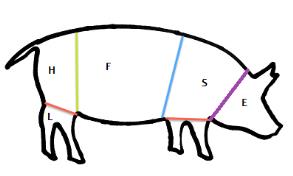Body marks
Why is it measured?
Body marks are primarily caused by aggressive interactions between pigs, but may also be caused by a poorly designed environment. Aggressive interactions, fear and the wounds associated with fighting are considered detrimental to the welfare of the pig. The location and type of body marks present and any obvious patterns on pigs within a pen can help identify risk factors and appropriate action to reduce these risks in the future. For example: wounds of the head and shoulder are associated with fights for social rank particularly in a restrictive environment that limits effective dispersal and the display of appropriate submissive behaviour; those of the rear with competition for food and lesions on the back may be caused by persistent mounting behaviour. There is a general trend for an increased risk of limb and body lesions in sows housed on slatted floors.
The aggressive interactions associated with body marks result in energy expenditure and therefore poorer feed conversion. Lesions of the ear and shoulder are associated with the greatest reduction in growth and may result in a greater impact on productivity.
How to assess and score using the AssureWel measure
| Body marks (dry sows and finishing pigs) Individual measure |
Observation: Stand near the animal and visually assess one side only.
Scoring: |
| 0 None - Minimal = |
No lesions or less than mild lesions as described below.
|
 |
| 1 Mild = |
A linear lesion longer than 10cm;
Or 3 or more 3cm lesions;
Or a circular area larger than 1cm diameter but less than 5cm diameter.
Definition of lesion includes grazed/broken skin, fresh (i.e. bleeding) wounds and healing lesions (scabs).
Scar tissue is not included.
|
| 2 Severe = |
Circular Lesion or area of lesions ≥ 5cm diameter;
Or lesion extends into deeper layers of skin;
Or the lesions cover a large percentage (>25%) of the skin.
|
Body regions: |
If >25% with marks, identify any noticeable pattern in the pen: Shoulder (S); Hindquarters (H); Legs (L); Flank (F); Ears and Head (E); General, if there is no obvious pattern (G). |
Deep tissue injury may also need to be recorded under ‘Pigs needing further care’.
Do not include vulva or shoulder lesions (typically shoulder lesions are round rather than scrape marks). [FOR DRY SOWS ONLY]
Record if too dirty to assess.
|